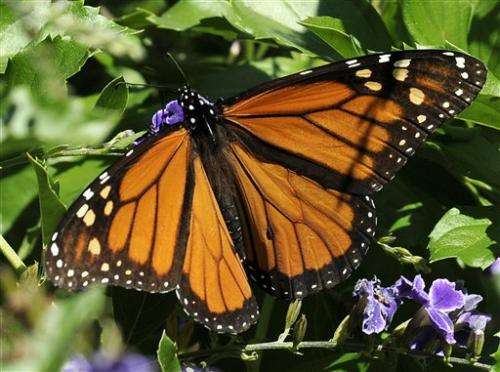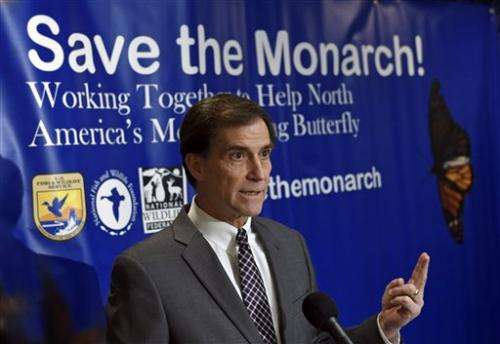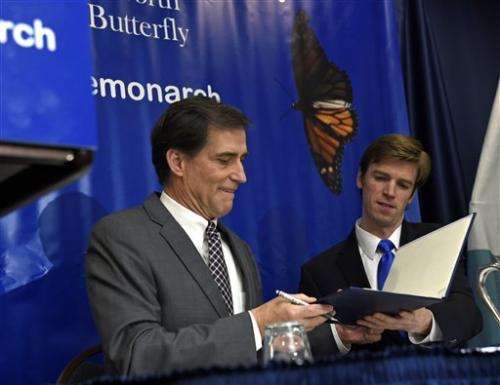This photo taken Oct. 25, 2014 shows a Monarch butterfly feeding on a Duranta flower in Houston. The federal government pledged $3.2 million on Monday to help save the monarch butterfly, the iconic orange-and-black butterfly that can migrate thousands of miles between the U.S. and Mexico each year. It has experienced a 90 percent decline in population recently. About $2 million will restore more than 200,000 acres of habitat from California to the Corn Belt, including more than 750 schoolyard habitats and pollinator gardens. The rest will be used to start a conservation fund that will provide grants to farmers and other landowners to conserve habitat. (AP Photo/Pat Sullivan)
The federal government on Monday pledged $3.2 million to help save the monarch butterfly, the iconic orange-and-black butterfly that can migrate thousands of miles between the U.S. and Mexico each year. In recent years, the species has experienced a 90 percent decline in population, with the lowest recorded population occurring in 2013-2014.
About $2 million will restore more than 200,000 acres of habitat from California to the Corn Belt, including more than 750 schoolyard habitats and pollinator gardens. The rest will be used to start a conservation fund—the first dedicated solely to monarchs—that will provide grants to farmers and other landowners to conserve habitat.
The move by the U.S. Fish and Wildlife Service comes as it's in the midst of a one-year review to determine whether to classify the monarch butterfly as a threatened species under the Endangered Species Act, which would afford the butterfly more protection. In December, the agency said that there was enough evidence to trigger a review.
"The magic of the monarch butterfly is that little patches matter," said Service Director Dan Ashe at a news conference in Washington. Piece by piece, he said, "we can make a difference on a continental scale."
The monarch lays its eggs exclusively on the milkweed plant. Conversion of prairies into cropland and the increasing use of weed killer-resistant crops have greatly reduced the extent of milkweed, officials said.
"It is weed control that is driving eradication of the milkweed plant," Ashe said.
The conservation projects will be focused on the I-35 corridor from Texas to Minnesota, areas that provide important spring and summer habitat along the butterfly's migration path. The species also faces challenges in Mexico, where its primary wintering grounds are being threatened by logging and climate change. Ashe said the hope was to eventually sign an agreement between Canada, the U.S. and Mexico to cover their entire range.
U.S. Fish and Wildlife Service Director Dan Ashe speaks during a news conference at the National Press Club in Washington, Monday, Feb. 9, 2015, on efforts to help save the monarch butterfly, the iconic orange-and-black butterfly that can migrate thousands of miles between the U.S. and Mexico each year. (AP Photo/Susan Walsh)
Environmental groups who have pressed for the butterfly's protection said Monday the announcement was a positive step, but said the species needs legal protection.
Monarchs are pollinators and indicators of broader environmental problems. Some populations migrate thousands of miles, across multiple generations each year from breeding and wintering grounds.
U.S. Fish and Wildlife Service Director Dan Ashe, left, and National Wildlife Federation President and Chief Executive Officer Collin O'Mara, exchange papers as they sign a memorandum of understanding at the National Press Club in Washington, Monday, Feb. 9, 2015. The memorandum proved a framework for cooperation with efforts to help save the monarch butterfly, the iconic orange-and-black butterfly that can migrate thousands of miles between the U.S. and Mexico each year. (AP Photo/Susan Walsh)
"The specter of listing will spur a lot of conservation for the monarch," said Tierra Curry, a senior scientist with the Center for Biological Diversity, one of the groups that asked the Fish and Wildlife Service last August to protect the monarch butterfly and set aside critical habitat.
But Curry said the butterfly needed to be listed for it to recover.
© 2015 The Associated Press. All rights reserved.























